By Natalie Pikulski
The first blog in this series examined federal public opinion polls about voter support from November 7, 2015 to May 4, 2019. The next two blogs examined voter support by gender and by age groups. This fourth and final blog will look at regional differences and similarities in terms of voting trends and what it could mean for the upcoming election.
In Atlantic Canada, the Liberal party saw high voter support during the 2015 election and throughout the post-election year polling significantly over 50%, even reaching above 70% support in some polls. This high starting point for the Liberals paired with lower support for the Conservatives in 2016 meant that the trend of party overlap and gap closure is only occurring in early 2019. Both parties are polling around 40% making the drop in Liberal party support in this region the highest in Canada.
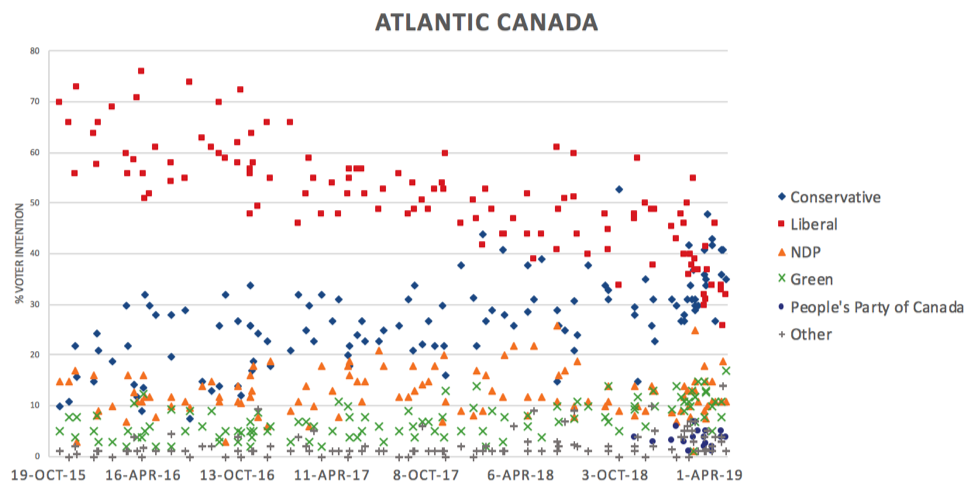
Ontario shows similar trends to the national average where Liberal support remained high (around 50%) for the first year after the election which eventually began to slip while the Conservatives saw a decreasing range from 15-35% in 2016 to 20-35% by early 2017. The two parties saw an eventual overlap starting in late 2017 at 35% – 45%. As of 2019, both parties declined in support, but the overlap is still strong at 30% – 40%, too close to claim a lead just yet.
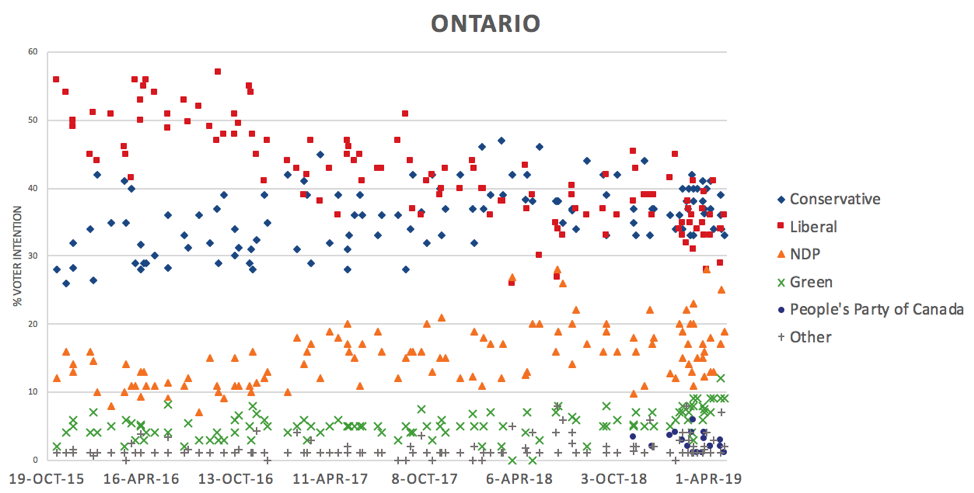
The trends seen nationally, in Atlantic Canada, and Ontario are also noticeable in British Columbia. An overlap between the Liberals and Conservatives began in late 2017 with both parties at 25% – 40% support. This continued for about a year until early 2019 when Liberal support dropped to 25% – 35% while Conservatives stayed within the same range with a few outlier polls, putting them in a slight lead as of May 2019. One thing to note about British Columbia is the considerable amount of support for the Green Party at 10% – 20% which is approaching support levels similar to the NDP which stand at 15% – 25%.
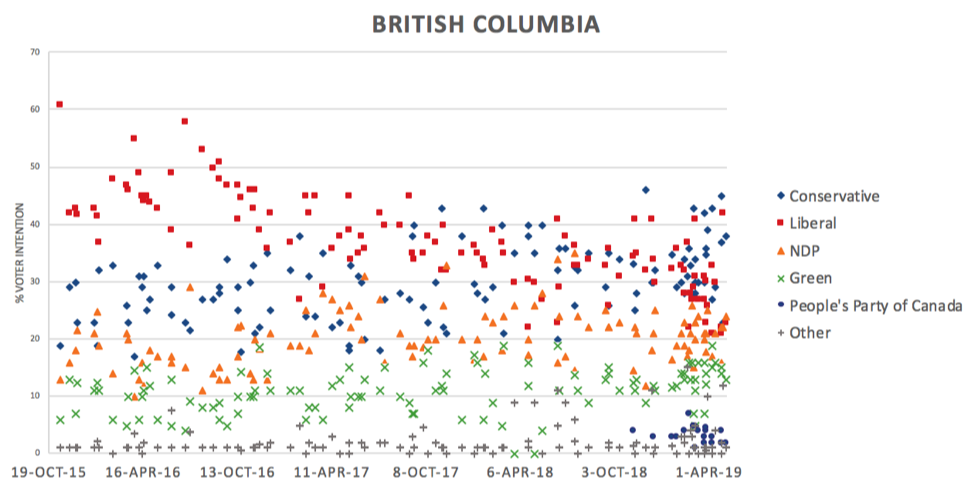
In Alberta, Conservative support has typically been much higher than elsewhere in Canada. Other regions had Liberals polling significantly higher than Conservatives right after the 2015 election, it was quite the opposite in Alberta. Liberals polled as low as 20 – 40% in the post-election year while Conservatives were between 50% – 60%. However, the trend of falling Liberal and rising Conservative support can still be noticed in the province with Liberals slipping to 15% – 25% and the conservatives reaching 60% – 70% support in 2019. The gap between the two parties is unlike any other region as there was never an overlap and the trend indicates a gap expansion, not a closure.
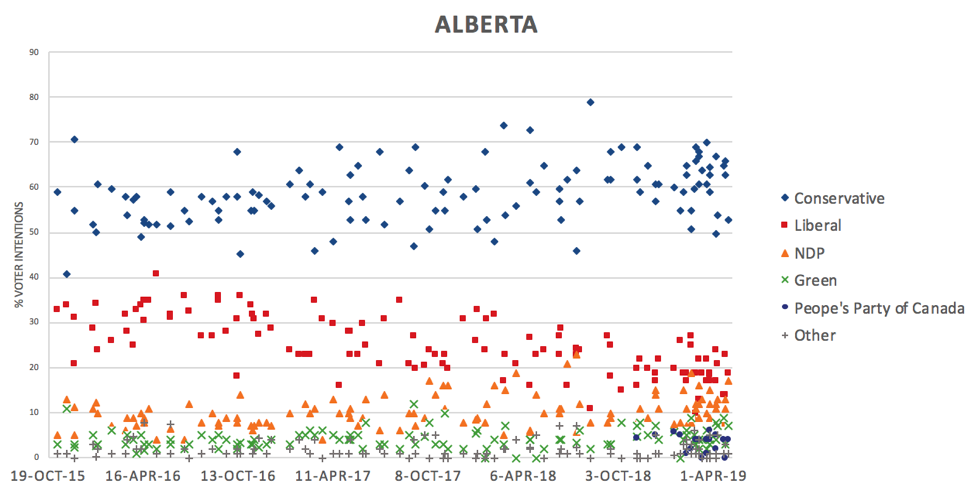
The Prairies region has a similar trend to Alberta where the support gap is opening, however, the difference between Alberta and the Prairies is the starting point of the two parties. After the election, Liberal and Conservative support largely overlapped for most of 2016 at around 30% – 50%. Alberta’s gap was much larger than the Prairies but the trend of significant Conservative growth and Liberal decline that opened the support gap is still visible.
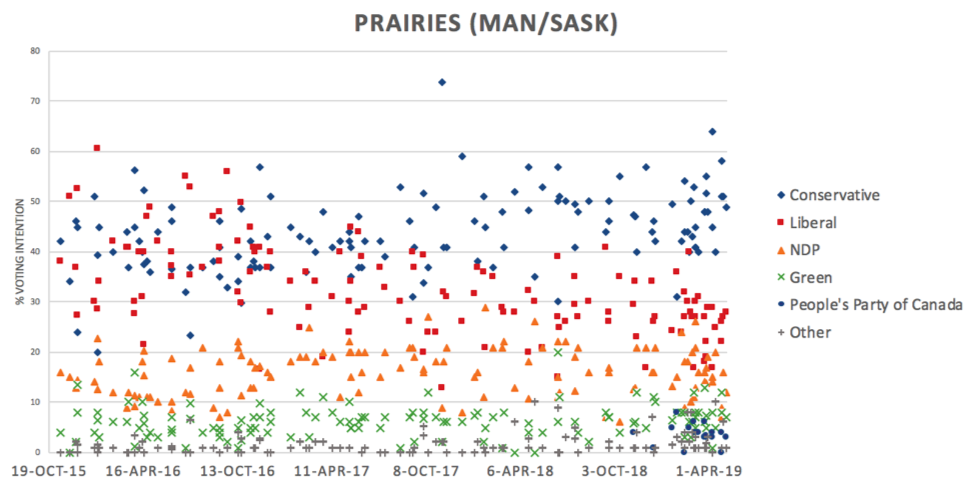
Voter intention in Quebec has generally followed the same falling Liberal and rising Conservative support trends but unlike other regions (apart from Alberta) the gap in voter intentions has not fully closed or overlapped at any point. Other regions have been seeing Conservatives pulling slightly ahead or overlapping significantly with the Liberals. In Quebec, the Liberals have maintained a higher level of support (25% – 40%) over the Conservatives (20% – 30%) in 2019.
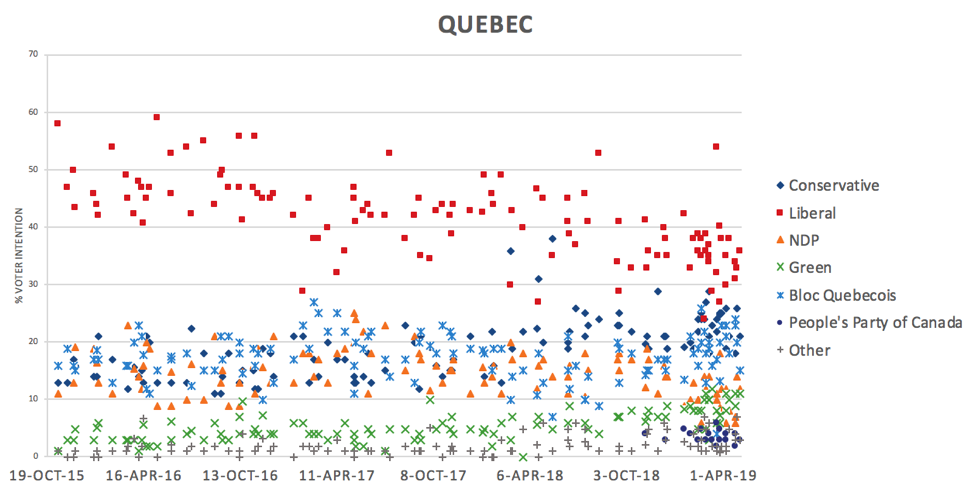
Liberal support in terms of vote intention percentages is similar to the national average and other regions like Ontario, BC, and Atlantic Canada but what allows them to be ahead in the polls is the considerably lower level of support for the Conservatives. While the trend of falling Liberal and rising Conservative support is still seen, the Conservatives have not managed to reach the level of support needed to meet or pull ahead of the Liberals at this moment in time.
The BQ polled similar to the Conservative party (10% – 20%) since the election until mid-2018 where the Conservatives saw a slight increase to 20% – 30% that carried them to early 2019. Conservatives continue to poll slightly above the BQ, even with the sudden 2019 BQ increase that puts them at 15-25% support. This larger split in votes and slow growth of the Conservatives could explain why Liberals are still polling higher but this reasoning should get taken caution as there are many potential explanations that are not mentioned here.
Over the last four blogs, common voter intention trends could be seen in almost all demographic groups across Canada. Similar trends seen include: falling Liberal support that was consistently high in the first post-election year, significantly dropped early 2017, and continued to decline; rising Conservative support since the last election seeing them beat out Liberals in support numbers in most demographic groups; stable NDP and BQ; and a slight rise in the Green Party in 2019. These trends found in the polls will be something to look for during the fall 2019 election to see where they lead.
